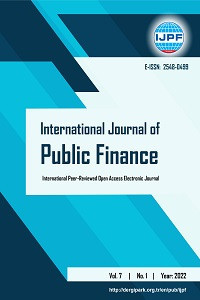Türkiye’nin İhracatının Yapısı ve Teşvik Politikaları
Ürün portföyünü çeşitlendirebilen ve karmaşık ürünler üretip ihraç edebilecek kabiliyetler kümesi geliştiren ülkeler hızlı büyüyor ve ekonomileri kalkınıyor. Bu çalışmada karmaşıklık ve çeşitlilik kavramları merkeze alınarak Türkiye'nin 1995 ve 2015 yılları arasındaki ihracat kompozisyonundaki yapısal değişimi ve bu değişimin Türkiye’de uygulanan teşvik politikalarıyla ilintisi incelenmektedir. Türkiye ihracatını karmaşıklığı yüksek seviyede olan ürünlere doğru çeşitlendirememiş ve dolayısıyla ihracat yapısını dönüştürememiştir. Bu başarısızlıkta Türkiye'nin 1995 yılından sonra seçici sektörel teşvik politikalarını terk etmesinin rolü vardır.
Anahtar Kelimeler:
Karmaşıklık, İhracat Çeşitliliği, Yapısal Dönüşüm, Açıklamalı Karşılaştırmalı Üstünlük, Teşvik Politikası
Structure of Turkey’s Exports and Government Incentives
Countries that have the ability to diversify their product portfolios and gather the set of capabilities required to produce and export complex products grow fast and achieve economic development. This study examines the structural change in Turkey’s export composition within the 1995-2015 period by focusing on the complexity and diversification of its exports. The findings show that Turkey has failed to diversify its exports into complex products to generate a structural transformation in its exports. Turkey’s abandonment of selective sectoral incentives after 1995 play a major role in this failure.
Keywords:
Complexity, Export Diversification, Structural Transformation, Revealed Comparative Advantage, Government Incentives,
___
- Amsden, A. (2001). The rise of the Rest, Oxford University Press, New York.
- Amsden, A. (2007). Escape From Empire: The Developing World’s Journey Through Heaven and Hell, MIT Press.
- Atiyas, İ. & Bakis, O. (2015). Structural change and industrial policy in Turkey. Emerging Markets Finance and Trade 51 (6):1209–29.
- Balassa, B. (1964). "The Purchasing-Power Parity Doctrine: A Reappraisal", Journal of Political Economy, 72 (6): 584–96. doi:10.1086/jpe.1964.72.issue-6.
- Bardhan, P. (2016). “State and development: The need for a reappraisal of the current literature”, Journal of Economic Literature, 54(3), 862–892.
- Ertan Özgüzer G. & Göksel, İ. (2018). "Türkiye ve Çin Ekonomilerinin Yapısal Dönüşümü: Karşılaştırmalı Bir Analiz", Ekonomik Yaklaşım, 29(107): 77-101.
- Eser, E. (2011), “Türkiye’de Uygulanan Yatırım Teşvik Sistemleri ve Mevcut Sistemin Yapısına Yönelik Öneriler”, T.C. Başbakanlık Devlet Planlama Teşkilatı Müsteşarlığı, Uzmanlık Tezi.
- Ersel, H. & Filiztekin, A. (2008). “Incentives or compensation? Government support for private investments in Turkey”, Industrial policy in the Middle East and North Africa: Rethinking the role of the state, (Ed.) A. Galal, Cairo, Egypt: The American University in Cairo Press, 35–50.
- Felipe, J., U. Kumar, A. A. & Bacate, M. (2012)." Product Complexity and Economic Development”, Structural Change and Economic Dynamics, 23: 36–68. doi:10.1016/j.strueco.2011.08.003.
- Hausmann, R., Rodriguez F. & Wagner, R. (2006). “Growth collapses”,CID Working Paper, No. 136,
- Hausmann, R., Hwang, J. & Rodrik, D. (2007). "What You Export Matters", Journal of Economic Growth, 12 (1): 1–25. doi:10.1007/s10887-006-9009-4.
- Hausmann, R., Hidalgo, C., Bustos, S., Coscia, M., Chung, S., Jimenez, J., Simoes, A. & Yıldırım, M.A. (2011). The Atlas of Economic Complexity. Hollis, NH: PuritanPress.
- Hidalgo, C. & Hausmann, R. (2009). "The Building Blocks of Economic Complexity." Proceedings of the National Academy of Sciences of the United States of America, 106(26),10570–75. doi:10.1073/pnas.0900943106.
- OECD. 2012. OECD Economic Surveys: Turkey. Paris: OECD.
- Rodrik, D. (2010). “Structural transformation and economic development”, Ankara, Turkey: TEPAV.
- Saviotti, P.P. & Frenken K. (2008), “Export variety and the economic performance of countries”, Journal of Evolutionary Economics, 18 (2), 201–18.
- Simoes, A.J.G. & Hidalgo, C.A. (2011). "The Economic Complexity Observatory: An Analytical Tool for Understanding the Dynamics of Economic Development." Workshops at the Twenty-Fifth AAAI Conference on Artificial Intelligence.
- Yanıkkaya, H. & Karaboğa, H. (2017). “The Effectiveness of Investment Incentives in the Turkish Manufacturıng Industry”. Prague Economic Papers, 26(6), 744–760, https://doi.org/10.18267/j.pep.641
- Yavan, N. (2011). “Teşviklerin Sektörel ve Bölgesel Analizi: Türkiye Örneği”, Maliye Hesap Uzmanları Vakfı Yayınları, Ankara: Atalay Matbaacılık Ltd. Şti
- Wade, R. (1990). Governing the market, Princeton: Princeton University Press, 1990
- Yayın Aralığı: Yılda 2 Sayı
- Başlangıç: 2016
- Yayıncı: Adnan GERÇEK
Sayıdaki Diğer Makaleler
Thomas DÖRİNG, Ruven Dominik OEHMKE
Cumhurbaşkanlığı Hükûmet Sisteminde Bütçe Hakkı ve Kanunu
Norveç Varlık Fonu Üzerine Bir İnceleme
Türkiye’nin İhracatının Yapısı ve Teşvik Politikaları
Türkiye’de Kamu Eğitim Harcamalarının PISA Göstergeleri Bağlamında Etkinliğinin Değerlendirilmesi
Halil SERBES, Nur Belkıs BEKTAŞ, Özhan ÇETİNKAYA
Devlet ve Mükellef Etkileşimi: Vergisel Yaptırım ve Kolaylıkların Yarattığı Mükellef Tipleri
